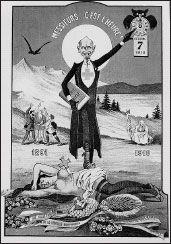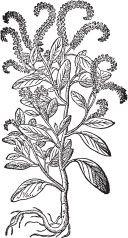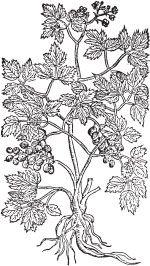Read Witchcraft Medicine: Healing Arts, Shamanic Practices, and Forbidden Plants Online
Authors: Claudia Müller-Ebeling,Christian Rätsch,Ph.D. Wolf-Dieter Storl
Witchcraft Medicine: Healing Arts, Shamanic Practices, and Forbidden Plants (40 page)

Wormwood is still used in a similar manner today: Extracts of the fresh flowering herb are administered as foundation tincture (Absinthium Ø) in modern phytotherapy and in complementary medicine as a tonic for states of exhaustion that accompany depression and present through digestive problems (one to three drops are taken one to three times a day, before or after meals).
But wormwood not only delivers an outstanding medicine; it is also a psychoactive substance. Absinthe was the name of a legendary drug favored by artists and bohemians at the end of the nineteenth century (Conrad, 1988). It consisted of schnapps that has been distilled from herbs, foremost from the thujone-containing wormwood. Schnapps made from absinthe has a much stronger and more unusual effect than other kinds. Among other properties absinthe is a strong abortifacient, due to the thujone content. Because it was both an intoxicating drug and an abortion medicine, it was made illegal at the end of the nineteenth century because of a supposed “escalation of abuse” (Vogt, 1981).
But in this case, as always throughout the history of the legal bans, the illegal substance continued to be distilled underground. Today absinthe is forbidden throughout the world, but it is still distilled behind closed doors in Switzerland (Lussi, 1997). The absinthe drinkers, who call their product the “green fairy,” care little about the prohibitions on its use. In Switzerland absinthe was forbidden mainly because it was used, or rather abused, for abortions. Those who are caught distilling it must pay a fine of a hundred thousand Swiss francs (Rätsch, 1996a).

In Switzerland on October 7, 1910, absinthe was outlawed. This contemporary caricature shows a Bible-thumping priest who has “killed” the “green fairy” with his religion (a knife in the form of the Christian cross)—the Church triumphs over heathendom. But the green fairy, a last manifestation of the witch goddess Artemis or Diana, lies hidden in home distilleries and still inspires absinthe drinkers.
Secret recipes for absinthe are carefully protected. In addition, other herbs are distilled in the mixture. Absinthe is clear, green, or yellowish in color. A Swiss person once explained that absinthe is the “most psychedelic alcohol there is.”
Because experiences with the thujone-impregnated schnapps are very rare, I would like to offer a short description of what I experienced. The taste reminded me very much of anisette or Pernod. It was diluted (about 1:1) with water. The mixture was milky and cloudy. The absinthe truly had an intoxicating effect on me, but totally different from “normal” schnapps. Absinthe is quite a powerful stimulant; it woke me up and kept me awake for a long time. At times I was flooded with aphrodisiac feelings, and at other times I flowed out of myself. As the effects increased I had the feeling of floating. It was like the kiss of the green fairy. As delightful as the intoxication the night before, so too was my head painful the next morning. I have never had such a brutal hangover.
Herb Christopher and the Solstice
Once when Artemis and her nymphs were bathing naked the Greek hunter Actaeon spied on them. The goddess noticed the secret admirer and became angry. As punishment she transformed him into a bellowing stag, and then fed an herb to her hounds, who went crazy and ripped the stag to shreds (Hyginus,
Myths
181). This remarkable herb of Artemis retains the name of its sacrificial victim: Actaeon.
The plant was later named herb Christopher after its patron, Saint Christopher, because of its supposed effectiveness against the plague. “The ancient figure of Christopher was a human with a dog head
(cynocephalus),
who mediates between life and death” (Beckmann and Beckmann, 1990: 119). Thus Christopher belongs in the company of Hecate and is one of the guardians of the travelers. It is interesting to note that the folk name
Heydnisch Wundkraut
(heathen woundwort)
104
was used for a long time. Today herb Christopher and baneberry are common names for
Actaea spicata
L. (syn.
Actaea nigra
[L.] Ph.).
Herb Christopher (
Actaea spicata
L.) was a famous magical and poisonous herb, hence the names “conjuring herb,” “bewitching herb,” or “witches’ herb.” Its shiny black berries are poisonous; they are used as
Mutterbeeren
[mother berries, Eifel region] for women’s problems (Aigremont, 1987: vol. 2, 68f.)

European heliotrope (
Heliotropium europaeum
L., Boraginaceae) was also called herb Christopher or cancerwort. Praetorius reported that the magical plant grows only on the Brocken, or Blocksberg (Harz Mountains), and is gathered there by witches. Nevertheless, the plant is actually found in southwest Switzerland. (Woodcut from Gerard,
The Herbal,
1633.)
In the early modern era baneberry was called
Aconitum bacciferum
and classified with the aconites because of its poisonous berries. Although it has the same qualities as monkshood, it was not used medicinally (Gerard, 1633: 980). In Norway the plant is called troll berry (Beckmann and Beckmann, 1990: 119); in Swabia it is simply known as
Hexechrut
(witches’ herb).
The cunning with which the devil uses natural things to win new brides is attested to by the shiny black, enticing berries we often see when we walk through the woods. Because birds eat them without harm it seems as though they would not harm a human, and so the children pick these fruits. Their poison causes fever and when the little one starts mumbling confused words the people think that the child is bewitched, perhaps even by the person who showed him the herb. The juice of the odorless root, also called black root, is emetic and is used against the plague, to push the evil out of the body. This drug is also taken against asthma and consumption (Ludwig, 1982: 149).
Herb Christopher was also identified with heliotrope or cancerwort (
Heliotropium europaeum
L.; European heliotrope). According to the ancient sagas, this plant comes from a nymph who was in love with Helios, the tribal father of the race of witches who was abused by the sun god.
As for Clytie … the author of light no longer came to her and made love to her no more. She wasted away after that, driven mad by her passions. For unable to endure the company of her sister nymphs, she sat out in the open on the bare ground night and day, her head uncovered and her hair uncombed, and went without food and water for nine whole days, sipping only a little dew and her own tears, and remaining on the ground, not moving, only watching the god, following him with her gaze as he crossed the sky. They say her limbs grew into the ground. The part of her that was pale and wan changed into bloodless leaves while her face, the part that was tinged with red, became a flower most like the violet. Though she is held fast by her roots she always turns to face the sun, and though she has been transformed she loves him as much as ever (Ovid,
The Metamorphoses
IV.256–271).

Herb Christopher (
Actaea spicata
L.) is one of the most important plants of witchcraft medicine. (Woodcut from Gerard,
The Herbal,
1633.)
Of the heliotrope, also known as
emeatites
(Titan’s blood),
105
is said that “it grows everywhere, on cultivated and bare places, and on meadows. The flowers of this divine plant follow the path of the sun, and when it sets the flowers close; when the sun rises again the flowers open again. It is effective in many medicinal remedies” (
Medicina antiqua
50, fol. 52r). The finely pulverized plant in good aged wine “removes all poison” (
Medicina antiqua
50, fol. 62v). Of heliotrope it is also said that “where this plant grows, no magic will approach and no witches. … If one carries it with them, then no demons and no witches will harm them” (
Medicina antiqua
50, fol. 152r). Because heliotrope is very rare in central Europe it is believed to have grown on the most famous of German dancing places for witches, the Blocksberg, or Brocken, in the Harz Mountains: “The heliotrope only grows there and nowhere else. All witches ride there on long-haired lusty bucks”
106
(Praetorius, 1668 [1979]).

Goldenrod (
Solidago virgaurea
L.), just like herb Christopher, was once called heathen woundwort. It is an ancient wound medicine. (Woodcut from Fuchs, 1545.)
Heliotrope was also said to have been an ingredient in witches’ salves (Beckmann and Beckmann, 1990: 160): “In magic it is called a witches’ herb, one which must be gathered on Sunday if it is to have any sort of magical effect. It was used as protection against bewitchment” (Gessmann, n.d.: 87). During the nineteenth century it was sold in pharmacies to women and prostitutes because the aroma was known to make men amorous (Aigremont, 1987: vol. 1, 15).
The Mother of the Witches
Artemis/Diana was reinterpreted during the Middle Ages as a witch goddess par excellence. The Church’s perspective was made clear by Regino of Prum in his
Canon episcopi
from the ninth and tenth centuries. He named “certain immoral women, who had been perverted by the devil, who are seduced by illusions and fantasies, who believe and admit that they ride through the night on animals with Diana, the goddess of the heathens, and that countless women ride out, and that they put great distances behind them in the deadly still of the night, following the orders of their mistress” (Naegele, 1997: 14).
Flying Ointments and Lovers’ Salves As Medicine
The famous witches’ salves, the substance with which the alleged witches “traveled out”
107
during the night, is not an invention of the Inquisition; it had already been mentioned many times in ancient texts (Luck, 1962).
